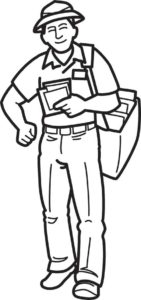
Type One Description
For the purpose of contrast 2 types of posture will be compared. First there is “proper”, “correct”, or, “Type 1” posture instruction. Most experts on search results for “proper posture” or “correct posture” are laser focused on this type. “Type 1” instructors direct you to maintain this position. “Type 1” posture instruction is an umbrella term used in this blog site to develop a contrast to “Type 2” instruction
I list this as the first of these type of posture not because it is more or less correct. I list it first because search resul ts indicate it is the most popular type of “proper posture” instruction. Therefore pardon the repetition but I want a strong understanding of the structural differences of these two concepts.
ts indicate it is the most popular type of “proper posture” instruction. Therefore pardon the repetition but I want a strong understanding of the structural differences of these two concepts.
Then, by looking at some top search result organizations that largely endorse the same posture position, and training, you’ll recognize how strongly “Type 1” postural thinking is imprinted.
To start, type 1 posture will be differentiated by calling it: the 6,000-year-old, static, confusing, rigid, traditional, proper posture, civilized, correct, common posture. It’s the arbitrary way you were trained to stand,
Consequently it’s the way you stand if you’ve had good training. It’s when you’re standing “straight and tall”. It’s the politically correct posture. It could be called many other names such as display posture, formal posture, parade posture, developed world posture etc, etc, etc…,
No Definition
There is no definition or clear instruction in our culture to define, describe, or differentiate this formal way of standing, sitting and walking from an informal way of standing, sitting and walking.
So with these results and reviews you’ll get an idea of the number of organizations that are wrong, contradictory, confusing, unclear, even unhealthy when it comes to posture.
To put it another way, this common postural instruction is a display posture carried too far. It’s necessary for certain occasions. But should not be used as a motionless ideal. It shouldn’t be a standard of prolonged personal postural behavior. This first type of posture should be used for formal, cultured, and other certain, occasional events only.
Type1 goes with your formal, your tuxedo, and your uniform. This is the way you were taught to stand, sit, and walk in school and by example from your parents. When they were children our parents learned this way of standing, walking and sitting. They learned it in school and from their parents. No instruction on “types of posture”.
For Type 1 posture, you stand up straight and tall. You stand with chest out, shoulders held back. It’s part of our culture. It’s needed when the time and season arise. It should not be maintained for extended periods or damage will occur fast. It’s not truly balanced though many instruct that it is.
In the military we’re all familiar with the, “attention” type of posture very seriously instructed. But the, “at ease” type posture we get no instruction at all. You’ll see that Type 2 posture instruction is the “at ease” part of posture instruction. There are no distinctions regarding types of posture in the military.
Type 1 Posture Definitions
Type One Definitions:
 Google “posture” and you come to a definition of posture stated as: “the position in which someone holds their body when standing or sitting.” Note the word “holds”.
Google “posture” and you come to a definition of posture stated as: “the position in which someone holds their body when standing or sitting.” Note the word “holds”.
Merriam Webster Dictionary :
- noun a: the position or bearing of the body whether characteristic or assumed for a special purpose. >erect posture.
(Erect posture implies holding. Implies rigid “stand up straight” standards. Does not stress motion or balance). - b: the pose of a model or artistic figure. Implies or emulates a held position as an ideal).
Acatoday.org or the American Chiropractic Association defines posture as follows:
- Posture is the position in which we hold our bodies while standing, sitting, or lying down. Note the word “hold”.
- Good posture is the correct alignment of body parts supported by the right amount of muscle tension against gravity. Note the word “correct”. Implies a static ideal or pose to be emulated or held.
- Without posture and the muscles that control it, we would simply fall to the ground.
Holding causes muscle imbalance. The word “control” implies holding.
None of the above definitions or characteristics stress balance or movement. These are two essential aspects of structural maintenance for the human body. Read on to gain an understanding of the difference between Type 1 and Type 2 postural concepts and the implications for you.

